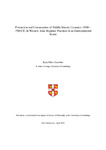The thesis presents a stylistic and technological study on Western Asian ceramics dating from 1000–1500 CE. The production and consumption of ceramics is used as a proxy to explore how social practices at the local level were formulated within the broader framework of Islam. The Islamic world has been studied as a relatively cohesive whole, due to the perceived connectivity of religion. This top-down approach favors elites (economic or political), larger cities, and precious materials (silk, porcelain, metals, etc.). This bias is mirrored in archaeological research which tends to focus on large palaces/castles/mosques, capital and large cities, and prestige goods. This dissertation focuses on the full repertoire of ceramic assemblages, not just glazed wares, to emphasize the potters’ choices in creating the ceramics, as well as the consumers’ choices in acquiring and using the ceramics. Both choices (production and consumption) are influenced by a myriad of factors, including vessels’ function, environment, and socio-cultural contexts. For this dissertation, I have three main questions: (1) What is the range of ceramic technology and style across Western Asia in the Middle Islamic period? How can the study of ceramic technology elucidate the ceramic traditions existing at these sites/regions? What is the structure of ceramic craft organization in these areas? (2) How can the ceramic traditions in combination with social dimensions of ceramic production be used to connect sites, regions, and interregional areas? How does the consumption of ceramics indicate links between these areas? (3) What can the study of ceramic traditions in the Middle Islamic period tell us about the connections between rural areas and larger urban areas? This dissertation focuses on 12 ceramic assemblages from various sites across Western Asia, all dating from 1000 – 1500 CE. These ceramics are recovered from both survey and excavation of sites of different natures, including eight rural sites (Erbil Plain Archaeological Survey (seven sites), Firuzabad), three intermediate types of sites (Nippur, Hasanlu, Chal Tarkhan), and a capital city (Rayy). The majority of the assemblages are from rural sites, but a few are from non-rural sites to lend a comparative edge and help define what is and is not rural. The ceramics are analyzed using a combination of macroscopic observation, thin-section petrography, portable X-Ray fluorescence (pXRF), and Fourier Transform Infrared Spectroscopy (FT-IR). These analyses are specifically selected to establish the potential provenience of the ceramics, reconstruct technical choices and social practices, and characterize production and consumption traditions. This area has been discussed as a homogenous whole (from 600 CE to present) under the assumption that the spread of Islam brought all areas under the larger cultural mainframe. However, this dissertation shows that there is heterogeneity in both ceramic consumption and production. The established overarching links do not seem to be influenced by the spread of Islam as the ceramic traditions identified (forms, fabrics, functions) also are present before the rise of Islam in these areas. This bottom-up approach marks significant contributions to Islamic Archaeology by shedding light on the diversity of dynamics that existed in local areas and among local populations and how these local dynamics play in the interconnected societies of Western Asia during the Middle Islamic period.
Relationships
Is supplemented by: Erbil Plain Archaeological SurveyUniversity of Pennsylvania MuseumOriental InstituteIdentifiers
This record's DOI: https://doi.org/10.17863/CAM.92981

No comments:
Post a Comment